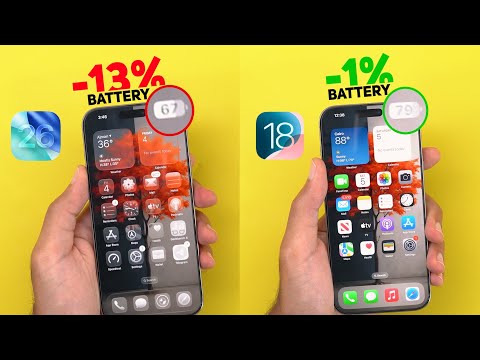
In this video, you will see some shocking results on how Apple's liquid glass animations could impact your iPhone's battery. Spoiler alert, it consumes 13 times more battery than iOS 18. So, let me show you how. As per the latest studies, we unlock our smartphones 150 times a day. Similarly, heavy smartphone users get up to 150 notifications daily. Beside how alarming the numbers are, think about how Apple's liquid glass heavy animations could impact your phone's battery and thermals. After using iOS 26 for a while, I started to notice how fast my 16 Pro Max's battery started to drain.
Plus, the phone gets considerably warm by just navigating the menus and checking the notifications, which never been the case before. So, I decided to do an experiment to see how much impact can Apple's liquid glass have on the iPhone's battery and thermals. Here I have the 16 Pro Max running iOS 26 developer beta 2 and the same phone running the latest stable version after downgrading to iOS 18.5. In this comparison, I will do four tasks. Check the notification center, open and close apps, do some scrolling in Apple Photos, and unlock the phone 150 times each on both versions to measure the battery usage and the heat I get from the same phone on both versions.
The starting battery is 80%. The screen brightness is calibrated and I will do the test by hand to make sure it's as close as possible to reality. So, let's begin. The first test is to check the notification center 150 times. Then I will measure the battery usage and temperature. I know checking the notification center 150 times back to back is not a common scenario, but we will get an estimate of the difference between both versions under the same conditions. We all agree that iOS 26 has one of the coolest and most realistic glass animation when you pull down the notification center, but it's not as cool on your battery or CPU. This animation alone requires a lot of processing power. Plus, we do this action between 100 to 150 times a day.
So, after trying this for 150 times back to back on both versions, look at the shocking results I got. Starting with the thermals, iOS 26 raised the 16 Pro Max's temperature to 39.4° C, while the same action on iOS 18.5 on the same phone was only at 27.8. It's 11.6° difference, which is insane. What's even more alarming is the battery usage. iOS 26 lost 4% battery going down from 80% to 76, while iOS 18 didn't lose any battery just yet. The battery is still at 80%. So overall, the iPhone lost four times more battery and generated 11.6° more heat under the same exact conditions. So if you want to downgrade to iOS 18 without losing data, I have a solution for you. Upgraded to iOS 26 and now your iPhone is stuck, buggy, or just not working right? You are not alone. Trying to downgrade with iTunes? Get ready to lose all your data and start from scratch. But there is a safer and smarter way. Meet Dr. Phone system repair. Dr. Phone lets you downgrade from iOS 26 or fix over 150 iOS issues. No jailbreak, no iTunes, and no data loss. Just a few clicks and you are back to the system you know.
Want extra peace of mind? Use the backup function to save your important data before you start. Unlike iTunes, Dr. Phone keeps your photos, messages, and apps safe. No more factory reset. No more headaches. Get your device back in just a few easy steps. Don't let a buggy update ruin your day. Click the link in the description to download Dr. Phone System Repair now and take control of your iPhone safely and easily. Back to the video. And the second test is to open and close Safari 150 times back to back to see how the liquid glass icons on my home screen could impact the iPhone's battery and CPU. After doing the same on both versions, on iOS 26, the 16 Pro Max's temperature jumped to 40.4° C. This number should only be seen when I play a heavy game. But guess what? iOS 26 can reach this number by just opening and closing apps. In contrast, the 16 Pro Max remained much cooler with iOS 18 to max out at 28.1°. That's a 12.3° gap, which is bigger than the 11.6 difference of the previous test.
What's even more shocking is the 16 Pro Max is still at the same 80% battery we started with on iOS 18, while on the newer version, it went down from 76 to 74%. So, it lost two more% in the second test. So far, iOS 26 consumes six times more battery than iOS 18 under the same conditions. The third test is to do some scrolling in Apple Photos, which is one of the best examples of Apple's liquid glass in firstpart apps. I will do 150 scrolls. A pair of an up and down swipe will be counted as one scroll. I thought at first that this test will give me similar results on both versions, but I was completely wrong as halfway through the test, the 16 Pro Max started to be extremely laggy around the 80 scrolls mark, while with iOS 18, it was just flying without a problem.
It kept getting worse over time with iOS 26. And here's a final look at the difference between the two before ending the test. It reminded me of the 14 Pro Max's performance in my heavy workload test two years ago, even though I'm just scrolling in Apple Photos. So, let's measure the numbers. The temperature maxed out at 40.3° with iOS 26 versus 29.6 on iOS 18, which is a 10.7° gap. Plus, the 16 Pro Max is still holding its 80% battery without losing a single percentage point on iOS 18 just yet.
While on iOS 26, the battery went down from the 74% of the previous test to 71%, which is a 3% loss. That means that since we started this comparison, iOS 26 consumed 9 times more battery than iOS 18 under the same conditions. And now, let's do the final test. But first, let me tell you about my wallpapers pack. If you like any of the wallpapers you see now on the screen, they are available for sale on my Patreon page. Whether you use iOS 26 or iOS 18, they look great either way, and you will find the download link in the description. Back to the comparison, the last test is to unlock the phones 150 times on both versions. I started with 71% battery on iOS 26 and 80% on iOS 18. I didn't expect Apple's liquid glass to have any impact on such a simple task that we do more than 100 times a day.
But again, iOS 26 has a different opinion. After 150 unlocks, the temperature was at 40.4° versus 30.6 on the other side. And the battery went down from 71 to 67, losing 4% more in this test alone, while iOS 18 lost its first percentage point after running all four tests to be at 79%. And now, let's sum up the numbers. revealing the notification center 150 times. iOS 26 consumed 4% battery and raised the 16 Pro Max's temperature to 39.4° C, while iOS 18 remained at the same 80% with a maximum temperature of 27.8°. Opening and the closing Safari 150 times consumed 2% battery and the temperature was at 40.4° 4° on iOS 26 versus 0% loss in battery and a much lower temperature of 28.1 on iOS 18. In the third test, which includes 150 scrolls in Apple Photos, iOS 26 consumed 3% battery and reached a temperature of 40.3°, while iOS 18 didn't lose any percentage point at this stage since the beginning, and the temperature was at 29.6°.
Lastly, in the 150 unlocks comparison, iOS 26 lost another 4% battery and reached the temperature of 40.4°, while on iOS 18, the iPhone lost 1% after running all tests and ended the comparison with 28.1° C. So, in total, the 16 Pro Max lost 13% battery with iOS 26 versus 1% on iOS 18, which is 13 times more battery usage just because of Apple's liquid glass. I know I'm comparing a beta version to the stable version and the Apple will optimize the software over time. But even if Apple optimized iOS 26 to consume half of this number when it gets released, we are still talking about 6.5 times more battery usage in the animations.
And you know what? Let's take it even further and imagine Apple will cut down the battery consumption to be four times less. It's still 3.25 times more battery usage. Bearing in mind that this comparison is done on the latest iPhone that has the most efficient CPU made by Apple. So, you are the judge. But either way, you should expect a big hit on your iPhone's battery with iOS 26. By this, I'm done with the comparison. And please let me know in the comments what do you think.
But for now, thanks so much for watching and see you in the next.


